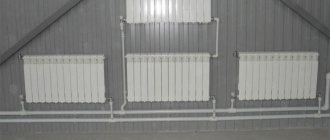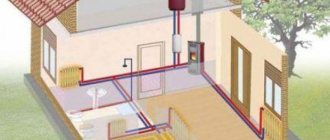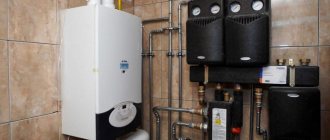Home / Electric boilers
Back
Published: 12/01/2019
Reading time: 4 min
0
3065
Arranging a heating system in a car garage, in situations where centralized heating services are not available, can be a difficult task.
Selecting the optimal electric heating scheme makes it possible to create the required sanitary and hygienic conditions in garage workshops at low outside temperatures, so owners of such premises need to know the basic rules on how to choose an electric boiler for a garage.
Example of EC location in a garage. Photo source: nizhniy-novgorod.dmir.ru
- 1 Types of boilers for garages
- 2 How to calculate boiler power
- 3 Requirements for installing an electric boiler in a garage
- 4 Best brands of garage electric boilers
- 5 How to connect
Features of water heating in the garage
The difficulty of a warm hangar lies in its inconsistent operation. If the heating is turned off for a long time, the circuit may break due to freezing of water in the pipes.
The main feature of water heating in a room is to warm it up to a temperature of + 5-8 0C. This will provide the necessary warm-up to the car and prevent the development of metal corrosion.
Advice! Filling water heating pipes with antifreeze will prevent rupture of system elements when the garage is not constantly heated.
The scheme includes:
- boiler;
- radiators;
- line for supplying hot water and discharging cooled water.
The boiler's job is to heat the water that moves through the pipes to the heating radiators. The cooled liquid is returned to the boiler in reverse and the circuit is cycled.
Tips for choosing
In order to choose the optimal one from the proposed heating systems, you need to compare their characteristics, installation complexity, operating cost and degree of usefulness, and then determine which one will be the more budget-friendly and most acceptable option.
Lucky are those who have a garage attached directly to the house - in this case, the heating system is usually installed in common. But a city resident who owns an apartment in a high-rise building will have to choose one of the above.
Below are the pros and cons of using one method or another to heat your garage.
Advantages and disadvantages of gas
Its advantages include low cost and good heat dissipation, as well as independence from the electrical network and a large selection of heaters for any room size and wallet thickness. But its disadvantages are quite serious: only specialists can install gas heating systems, and only after all permits have been obtained and the appropriate documentation has been drawn up. In addition, gas requires extremely careful compliance with safety rules, since it is a flammable substance, and its slightest leak can be fraught with unpleasant consequences.
Pros and cons of heating a garage with water
A warm room for a car saves it from corrosion, peeling paint, and freezing of lubricant. Heating a garage with a water circuit creates optimal storage conditions.
Experts often dispute the advantages and disadvantages of a warm room for a car. There is an opinion that in a heated garage in winter, snow accumulates on the bottom and walls, and when it melts it causes corrosive changes in the metal.
In any case, in a heated room, it is more comfortable for the car owner to carry out maintenance and repairs on a friend on wheels. Some car owners turn on the heating only during repair work, and the car itself is stored in an unheated room.
Knowing the advantages and disadvantages, the car owner independently decides how to store his car.
Safety precautions when heating a garage
Before you start heating your garage, you need to study safety precautions and adhere to them. Main criteria:
It is forbidden to heat a garage with gas equipment if explosive substances and mixtures are or will be stored in it. When entering a gas-heated room, you should sniff before turning on the heater. This method will help to avoid an explosion and notice a leak in time. It is necessary to think in advance about what technology is best to use to heat a car garage in winter even before it is built. If you decide to heat the building with electricity, then you need to install fuses
This is important because in the event of a power surge, the devices will continue to operate. You need to take into account the power of the electrical network. You cannot use equipment that is more powerful than the network itself. To ensure warmth in the garage, it is necessary to take care of ventilation and good thermal insulation in advance. When leaving, turn off electrical appliances. Install sensors that detect smoke. There should be a fire extinguisher in the garage.
Attention! Do not use heating equipment to dry clothes. Constantly need to monitor the condition of the devices
The choice of heating device depends only on the requirements of the car owner. But it’s better not to save on such equipment
You must constantly monitor the condition of the devices. The choice of heating device depends only on the requirements of the car owner. But it’s better not to save on such equipment.
Water heating schemes in the garage
At the design stage of the circuit, the diameter of the pipes is determined. The higher its value, the more efficient the heating will be.
The thermostat increases or decreases the supply of hot water depending on the area of the heated room
Next, calculate the required number of radiators to warm the room. At the design stage, approximate fuel costs are determined. The choice is made on a cheaper and more accessible form of energy.
There are 2 types of heating systems: one-pipe and two-pipe
The water heating circuit consists of a boiler, pipes and radiators.
Red pipes – supply line, blue – return line
The water heated in the boiler flows through pipes into the heating radiators, the metal warms up, transferring heat to the air, which heats the room. The water cooled in the radiators is returned through the pipes to the boiler and heated. It's a continuous cycle.
Water heating is the most economical for heating a garage
In a private house, it is possible to combine the heating system of the garage and the house into one circuit by installing a switch that turns off the heating in the garage. This type is the most budget-friendly
The supply and return lines are located at a slope
Experts recommend installing a unified heating system in cases where the garage is located from the house at a distance not exceeding 40 m.
The heating system of the 2nd floor of the room on which the workshop is located provides for a sequential arrangement of radiators
The gravity scheme includes:
- expansion tank;
- boiler;
- main pipes;
- radiators.
In a gravity system, water is supplied to the radiators through risers. For the garage, it is advisable to install autonomous heating if it is remote from the house, in which case the costs of materials increase. Instead of radiators for heating the garage, you can use pipes with a diameter of 5 to 10 cm. In the hangar, you can install a heated floor, having equipped it with a switch. Complex heating is being installed in a garage cooperative.
Installation of a solid fuel boiler with air heating
Installation of a solid fuel boiler with air heating (without connecting the liquid circuit) is carried out as follows:
- Preparing the place where it will be installed. The walls and floor nearby (at a distance of at least 50 cm inclusive) are finished with non-combustible material. The ideal option is to install a box made of refractory bricks.
- Chimney installation. It is better to “cut” the hole for the pipe using a powerful hammer drill and a diamond bit for stone. Such transitions in chimneys must be avoided. Over time, the seams can burn out, which will lead to smoke in the room.
- Boiler installation. Recommended performance is about 10 kW. If a pyrolysis boiler is installed, then the chimney should be additionally insulated (otherwise soot will regularly accumulate in it). The boiler and the chimney outlet can be connected with a corrugated metal pipe.
- Fixing the boiler (using dowels on the plates on the bottom). A mandatory item that many people ignore. Fixation allows you to avoid distortions and depressurization with the chimney. It is imperative to check that the boiler is level using a building level.
- Test warm-up (one fuel load). At the same time, the tightness of the connection with the chimneys and the absence of reverse draft are checked.
A solid fuel boiler can also be placed outside the garage in an extension; according to many criteria, this is more convenient. But in the garage itself, it is necessary to run a heating circuit or at least a radiator, heated by the boiler. The efficiency of such a system is much lower; part of the heat will be dissipated into the environment rather than entering the room.
In summary, there are a lot of options for economical garage heating systems, but the most profitable option is to install a solid fuel boiler with air heating (popularly referred to as “potbelly stoves”), running on coal, fuel oil, wood or wood briquettes. In this case, one-time heating of a garage of 25 square meters will cost only 40–60 rubles.
Methods for water heating of a garage
The choice of fuel significantly influences the heating scheme in the room. The frequency of operation of the circuit should be taken into account. If the garage is located far from the house and is not heated daily, then during severe frosts the pipes and radiator may rupture. At the design stage, you should carefully consider the type of boiler and type of fuel.
There are several types of fuel:
- gas;
- solid fuel (coal, firewood);
- liquid fuel (used technical oil);
- electricity.
Attention! Solid and liquid fuels require additional storage facilities for storage.
The choice is made based on the cost of fuel and autonomy.
Water heating in a garage without electricity
The most common fuel in the private sector is gas. The advantage of this type is its low cost and availability. Gas heating does not require constant monitoring. With an uninterrupted gas supply, continuous heating is ensured.
However, if the gas pipeline does not pass through the area in which the building is located, they choose a different type of fuel, since it is very expensive to install a gas line.
A gas boiler for autonomous heating is not a cheap pleasure, especially when it comes to heating a garage
Liquid fuel is a low-budget type. The big disadvantage of this heating option is the need for a place to store used oil. You will need a large number of barrels or canisters and a place where you can store all the supplies. This is a fire hazard.
If you have a boiler for liquid fuel, you must constantly monitor its filling level, so you will have to visit the garage often to prevent the heating pipes from bursting
A solid fuel boiler will help you set up water heating in your garage using wood, coal, garbage or pressed briquettes. This option is suitable if the owner can visit the hangar every day and throw a portion into the firebox. After all, in the garage it is enough to ensure a positive temperature; there is no need to warm up the room too much. If a new portion of fuel is not added in a timely manner, the system may freeze and the pipes may burst.
A solid fuel boiler requires a constant portion of fuel, otherwise the system will cool down
For the hangar, you can install water heating using a potbelly stove. This oven is designed for a room up to 30 m2.
Water heating in the garage from electricity
An electric boiler is the most optimal option for a water heating scheme in a room. There is no need for an additional pipeline or storage area to store fuel.
An electric boiler provides reliability and comfort and does not require additional installation of a chimney or supply
Advantages of an electric boiler:
- compactness;
- reliability;
- does not require installation of a supply line;
- does not require the construction of a chimney;
- the device is equipped with a safety system: in case of overheating, the system will turn off;
- can operate on battery power during an emergency shutdown;
- In the event of an emergency power outage, the boiler will start working on its own.
Despite the high cost of electricity, the choice of this heating scheme is optimal, since it is enough to warm the air in the room to positive temperatures, and little fuel is required.
The best brands of garage electric boilers
Energy-saving electric boilers for heating a car garage are produced by Russian and Western manufacturers.
In order to limit the boundaries of the search, settings are systematized into categories based on the operating principle used:
- New electric heating boilers: Elvin EVP-6 EU, EVP-9 Teplotechn, E.V.P.M LLC "Resurs-ElectroTerm", E.V.A.N EPO 2.5 kW, "Stanless" E.V.P- 6M, Novel-Evos 2/4/6-220.
- Induction boilers: SAV-PROF 2.5, Spec-SAV-20.0.
- Modifications of the Galan electrode type: Hearth 3(N), Vulcan (25 kW).
For heating garage workshops, a domestically produced electric heating apparatus has the best balance between cost and production quality.
It is possible to buy a Russian-made heating element device within the range of 10,000-14,000 rubles. Replacing the electric heating element, which will be needed after about 5 years of use, will cost only up to 2000 rubles.
Types of water heating garage
Water heating in a garage without a pump can be achieved using a gravity heating system.
There are 2 schemes:
- single-pipe;
- two-pipe.
Single-pipe water heating in the garage
Water heating in the garage from the stove is equipped using a single-pipe scheme. This scheme ensures the sequential passage of coolant through the radiators and return to the boiler.
A single-pipe heating system is easy to install and does not provide uniform heating of radiators
A significant disadvantage of the single-pipe scheme is the uneven distribution of heat. The first radiators will be significantly warmer than the last ones. Experts say that this problem is acute in multi-story buildings and less noticeable in single-story buildings.
Two-pipe water heating in the garage
In a hangar with a large area, experts recommend installing water heating using a two-pipe system. The first pipe pumps heated coolant to the radiators. The second drains waste fluid from the batteries back into the boiler.
The two-pipe system ensures uniform distribution of coolant throughout all radiators
The temperature of the radiators will be uniform, which will ensure uniform heating of the air. The disadvantage of this scheme is complex installation and a large number of pipes and shut-off elements, which increases its cost.
Types of boilers for heating small areas
It is important to note: such devices are easy to install. The garage owner does not need to obtain permission to operate an electric boiler. Before choosing a device for heating a room, you need to study the principle of its operation and identify the pros and cons.
Electric boilers used in garages differ from each other in the way they heat the coolant, and they also have different mechanisms inside.
- Heating element boilers. The devices are presented in the form of heat-insulated containers equipped with heating elements (tubes located inside). Heating element boilers have disadvantages. The heating medium is heated indirectly, which results in heat loss. It takes a certain amount of time for the device to reach acceptable operating power.
- Electrode type boilers. The devices have 2 electrodes that simulate an electromagnetic field with a frequency of 50 Hz. This field ensures the movement of ion salts dissolving in the thermal fluid. Result: the coolant heats up instantly. Electrode boilers have 40% higher energy efficiency, but they use a lot of salt to heat the area.
- Induction devices. Their functioning is based on an alternating electromagnetic field. The devices carry out indirect heating of the thermal fluid, the heat is transferred to the liquid that circulates inside. Induction boilers last a long time and are affordable.
How to make water heating in a garage
Arranging water heating from a potbelly stove in the garage is advisable if the area does not exceed 30 m2.
To install the system you will need:
- oven or boiler;
- cast iron radiators;
- metal pipes with a diameter of 5-10 cm for arranging the main line;
- locks, screws, fasteners.
The number of radiators and sections in them is determined based on the heated area of the building and the expected fuel consumption. Standard formula: 1 equals 100 watts. Calculations for 20 m2: 100*20=2000 W. The package indicates the heat transfer index of 1 section, for example, for cast iron - 120 W. 2000/120= 16.67 sections. This formula is used to heat a living room. It is not necessary to warm up the garage to a temperature of 20 0C, so experts advise dividing all calculations by 2. For a room of 20 m2, 16.67/2 = 8.33 sections will be required. The value is rounded up or down.
Attention! The diameter of the pipe affects the heat transfer. The higher the value, the more efficient the heating of the room and the lower the fuel costs.
During the installation process, metal pipes are assembled into the system using a welding machine, and plastic pipes using a soldering iron. For natural circulation of the coolant, the pipes are placed at a slope.
The water heating circuit assumes the presence of an expansion tank. It is made from a canister or other plastic or metal container. In the upper part of the tank there is a hole for adding coolant, as the liquid heats up and evaporates.
The boiler is installed in a permanent place and pipes are supplied
Install the boiler. Pipes and, if necessary, a chimney are connected to it.
The boiler is installed in a permanent place and pipes are supplied
Radiators are hung on fasteners, evenly distributed around the perimeter of the room. The distance from the floor is at least 15 cm. A gap of 5 cm is left between the wall and the battery.
Radiators are hung from the wall and main pipes are supplied
Using main pipes, the entire structure is connected into a single circuit. When welding or soldering pipes, experts recommend paying attention to the quality of the seams. The circuit is filled with coolant and turned on for testing.
How to calculate boiler power
An extremely undemanding, albeit approximate way to determine the required power of electric boilers for heating a garage is based on the size of the area that needs to be heated.
The ratio of 100 watts per 1m2 is applicable for central Russia, where there is a warmer climate. For the southern regions, you will need to enter a coefficient of 0.8, thereby reducing the power, and for the northern, on the contrary, the result will be increased by a power reserve of 1.2-1.4.
Such standards have remained since Soviet times; they were based on the thermal qualities of the panel house construction material. Today, the building materials used to construct the structural elements of a building have different thermal characteristics.
Boiler selection table
Therefore, to obtain more accurate calculations, it is necessary to use data not only on the heated area, but also on the quality of walls, insulation, number of window and door openings, and heat transfer of roofing material.
For users who are not familiar with the laws of heat transfer of materials, it would be better to turn to the appropriate online calculators.
There are enough of them posted online to accurately determine such an important indicator for selecting an electric boiler.
Given
First, a few general notes to help you understand the proposed schemes:
- Part of the time the boiler is idle or operates at reduced power. Its rated power is selected to match the peak energy consumption of the house, which occurs on the coldest days of winter. When the thermometer rises, the need for heat decreases;
During the thaw, the home's need for heat decreases.
Thermal energy consumption, with constant thermal conductivity of the walls, is directly proportional to the temperature difference between the house and the street. It will decrease not only when the outside temperature increases, but also when the internal temperature decreases.
- The efficiency (coefficient of performance) of any electric heating device with a minimum error is 100% and does not depend on the type of heating element. The small amount of heat that is dissipated by the body of the device also goes to heating the house;
To reduce non-target heat losses, the boiler heat exchanger is insulated with mineral wool or teplovol (foil insulation based on heat-resistant foamed polymer).
Therefore, the thermal power of a boiler is always taken equal to its electrical power: a device that consumes 8 kilowatts of electricity will give off the same amount of heat.
- The average actual consumption of a boiler with correctly calculated power is approximately equal to half the consumption at rated power for the same time. Simply put, an 8-kilowatt appliance consumes 4 kilowatts on average during the winter months.
Having heated the water to the desired temperature, the boiler turns off the heating and waits for the coolant to cool.
Which units are suitable for a garage?
There are many models on the market. To weed out unnecessary ones and stop at one or at least several, you need to find out a few key points for yourself:
- how often or for how long the system will operate;
- Is it necessary to automate this process;
- the garage will additionally house a workshop or even some kind of production;
- Do you need constant hot water?
It is quite obvious that, having clarified all the points, it will be possible to choose exactly the right equipment.
So, for example, if there is a need for periodic heating and hot water supply, you can find inexpensive heating element electric boilers. They will cost less than others. However, you will need to constantly manage the system yourself. In addition, you will need to monitor the fluid level. In this case, the room will warm up as quickly as possible.
Connection
Installing an electric boiler in a garage is the same as in any other building. You need to place all the radiators around the area and connect them into the system. Then install the boiler itself in a suitable place. In addition, it is definitely worth introducing a water filter, pump, expansion tank, pressure and voltage fuses into the heating (if this is not provided in the unit itself).
Scheme 1: by power
If the average power of the boiler is known, it is not a problem to calculate how much the device consumes per month and over the entire winter.
| Calculation of daily consumption. | |
| Calculation of average monthly electricity consumption . | |
| Consumption during the entire heating season. |
Example
Let's find out, as an example, how much energy is needed for a boiler with a rated power of 12 kilowatts:
- Its average power is 12/2=6 kW;
- Consumption per day - 6*24=96 kilowatt-hours;
- Heating will consume 96*30=2880 kWh per month
- Electricity consumption during the winter with a heating season of 180 days (from October 15 to April 15) will be 180*96=17280 kWh.
The length of the heating season in your region can be found on this map. The heating turns on when the air temperature drops below +8 and turns off when the temperature rises above +8.
Now let's do one more calculation - find out how much heating will cost. I use data for a single-rate tariff in Sevastopol as of January 2022:
- When consuming up to 150 kWh per month, a social tariff of 2.42 rubles applies;
- In the range of 150 - 600 kilowatt -hours per month, the price increases to 2.96 rubles;
- Electricity over 600 kWh per month costs 5 rubles 40 kopecks.
Current electricity tariffs. Sevastopol, first half of 2022.
Of the monthly 2880 kWh, 150 will be at a reduced tariff and will cost 150 * 2.42 = 363 rubles. The next 450 kWh are paid at 2.96: 450*2.96=1332. The balance is 2880-600 = 2280 kWh for 5.40 rubles, or 12312 rubles.
Total 12312+1332+363=14007 rubles.
When using a single-tariff meter, electric heating will cost a pretty penny.
If you have a gas boiler of the same power installed, heating costs under the same conditions will be approximately 1,500 rubles. Electric heating is the most expensive way to heat a home.
Switching to mains gas will greatly reduce your home heating costs.
Electric heating
Shopping list
To create highly efficient garage heating with electricity, you will need to purchase:
- electric boiler;
- radiators;
- metal-plastic pipes;
- waterproofing material.
Let's take a closer look at how to use an electric heater using a do-it-yourself underfloor heating system. Making a heater of this type is not difficult if you follow the recommendations of specialists.
Step by step plan
Heating a garage with electricity using a “warm floor” system should be organized as follows:
- the base will need to be waterproofed using a special roll material;
- metal-plastic coolant pipes are installed directly into the concrete screed for uniform heating of the entire room;
- further, the pipes embedded in the concrete are connected to an electric radiator, a power source;
- if necessary, turn on the system, plug the wire from the radiator into the outlet.











